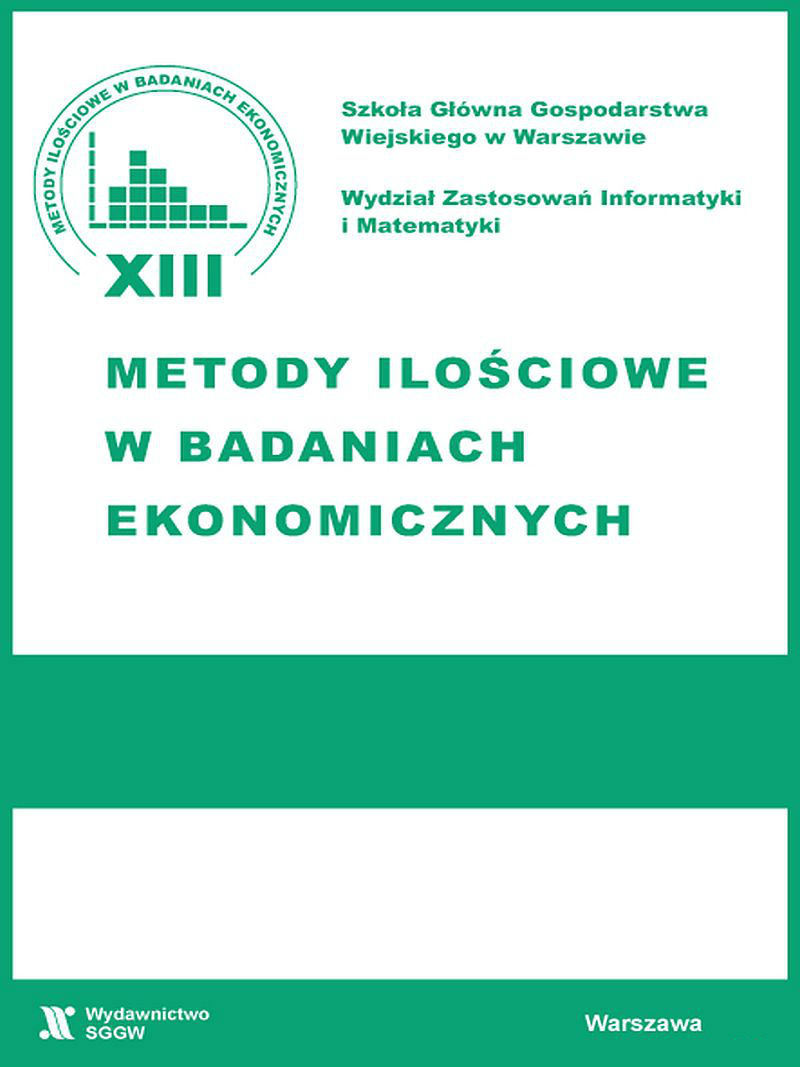
We kindly inform you that, as long as the subject affiliation of our 300.000+ articles is in progress, you might get unsufficient or no results on your third level or second level search. In this case, please broaden your search criteria.










We consider boosting, i.e. one of popular statistical machine-learning meta-algorithms, as a possible tool for combining individual volatility estimates under a quantile regression (QR) framework. Short empirical exercise is carried out for the S&P500 daily return series in the period of 2004-2009. Our initial findings show that this novel approach is very promising and the in-sample goodness-of-fit of the QR model is very good. However much further research should be conducted as far as the out-of-sample quality of conditional quantile predictions is concerned.
More...
Population ageing is one of the major challenges of modern Europe. In this context is worth to assessment the differences in the situation of women and men aged 50+ on the labour market. In the area of interest are primarily people aged 50-59/64, which are at this stage of life in which the situation on the labour market is particularly difficult. Paper was prepared mainly on the basis of the unpublished data developed within the project “Equalisation of Opportunities in the Labour Market for People Aged 50+”. The analysis was conducted with the application of basic descriptive statistics, as well as chi-squared test. Comparing income of women and men aged 50+, t-Student test and median test for independent samples, as well as one- and two-way analysis of variance were used.
More...
The aim of our research is the identification of factors affecting labour force participation (LFP) in the EU in the years 1998-2007 with a specific focus made on family policies. We perform the analysis separately for men and women, taking into account differences in the LFP levels and patterns observable among age and country groups. Our main findings suggest that generally the family policies are relevant for the age groups 15-24 and 40-59 in determining their LFS, while less influential for the age group 25-39. Nevertheless, significant differences in the sign and the magnitude of the influence exist between specific policy instruments.
More...
Open pension funds have existed on the Polish financial market since 1999. They are institutions which create this market by investing part of their members’ superannuation. So, it is difficult to overestimate their significance from a social point of view. Authors have presented results of quantitative investigations of the share of pension funds in this market from 2001 to 2012. Main attention is concentrated on WSE because pension funds invest in stocks and bonds (government, municipal etc.) listed on the Polish ex-change and these securities are the principal components of their portfolios.
More...
The program for pension system reform, launched at the beginning of 1997 in Poland, was called by its authors “Security through Diversity”. This title emphasizes that pension reform, which is designed to guarantee security for the insured, has to combine pay-as-you-go pillar together with mandatory, fully funded pillar as well as voluntary, funded pillar. This paper discusses consequences of the changes implemented in the year 2013 and consequently analyzes the changes in the composition of the pension funds’ portfolio, in particular the prohibition of investing in debt securities issued and guaranteed by the State Treasury.
More...
The behaviour of women and men in the labour market is diverse. Traditionally, men have closer attachment to the labour market. Women, however, have more family responsibilities. In the paper, we analyse the exit rates from unemployment for each sex separately, and find out that the effects of the explanatory variables in estimated duration models depend upon gender. We begin our study with a single risk hazard model. These estimations are extended to a competing risks model with two destinations: employment and non-participation.
More...
We examine the contribution of married and cohabited women and men to the joint income of the couple. We use individual income data from Household Budget Surveys for Poland in 2011 from a sample of 16,538 married and cohabited couples. The results of analysis show that contribution of men to total household income is higher than contribution of their female partners through the life cycle, controlling for type of a couple, education levels of genders and number of children. The contribution of married and cohabited women to total income of the couple remains almost flat during the life cycle.
More...
The turbulences of the contemporary financial markets lead to exploration of alternative assets such as art. The aim of this pilot study is to investigate for the price determinants of paintings on the Polish art market using transaction data from art auctions involving the works of 50 most significant Polish artists. The study proved that some factors are statistically significant for the price of paintings; these include the subject (i.e., self-portrait), the age and size of the artwork, and the reputation of the artist.
More...
The identification of tail (in)dependencies has drawn major attention in empirical financial studies. We concern on the structure of dependence which refers to dependence as symmetric or asymmetric, tail-dependent or tail-independent. We present the proper procedure of analysis dependence structure between some financial instruments. Our empirical results demonstrate different tail dependence structures underlying various global financial markets.
More...
The aim of this paper is a comparative analysis of contracts on electric energy at Polish Power Exchange (POLPX) and European Energy Exchange (EEX) spot markets. The approach considered in this article is based on minimization of the Conditional Value at Risk and maximization of portfolio rates of return. The analyzed portfolios were constructed with contracts noted on POLEX and EEX from 1st January 2011 to 31st December 2012.
More...
The aim of our research is to identify determinants influencing wages in Poland in the years 2001, 2003, 2006 and 2009. We want to find out if there is any changes in time and if gender can be considered as significant factor influencing wages. Investigation is provided on the basis of data from the Polish Labor Force Survey, applying ordered logit models.
More...